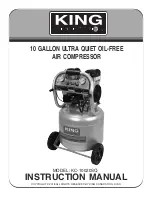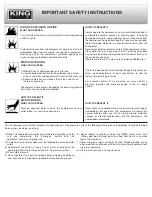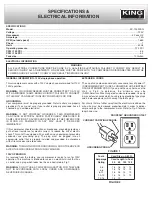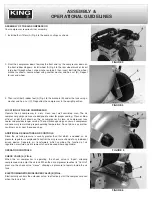
after Use:
1. Set the switch (A) Fig.8 to the Off position. Disconnect power cord from power source.
2. Turn the regulator (B) Fig.7 counterclockwise to set the outlet pressure to zero.
3. Disconnect the air tool or accessory.
4. Pull ring on safety valve (E) Fig.7, allowing air to bleed from the tank until tank pressure is approximately 20 PSI. Release safety valve ring.
5. Drain water from air tank. Turn drain valve (A) Fig.9, counterclockwise to open.
WaRnIng!: WaTER WIll conDEnsE In THE aIR Tank.
moisture in compressed air
When humidity is high or when the compressor is in continuous use for an extended period of time, this moisture will collect in the air tank. When
using a spray gun or sandblast gun, this water will be carried from the tank through the hose and out of the gun as droplets mixed with the spray
material. This will cause water spots in a paint job, especially when spraying other than water based paint. If sandblasting, it will cause the
material to cake and clog the gun, rendering it ineffective.
DRaIn WaTER fRom aIR Tank on a REgUlaR basIs
or an optional air control
unit with dirt and moisture removal should be used to prevent these undesireable results.
noTE:
If drain valve is plugged, pull ring on safety valve (E) Fig.7, and hold until all air pressure has been released. The drain valve can then be
removed, cleaned, and reinstalled.
6. After the water has been completely drained, turn drain valve clockwise to close. The air compressor can now be stored.
kEEp Tool clEan
Periodically blow out all air passages with dry compressed air. Clean all plastic parts with a soft damp cloth. NEVER use solvents to clean
plastic parts. They could possibly dissolve or otherwise damage the material.
caUTIon
: Wear safety glasses while using compressed air.
opERaTIon, maInTEnancE &
TRoUblEsHooTIng
TRoUblE
No start condition.
Low pressure.
Safety valve releasing.
Tank pressure drops
when compressor
shuts off.
Excessive moisture
coming out of air hose.
possIblE caUsE
Loose electrical connections.
Overheated motor.
Air leak in safety valve.
Defective check valve.
Defective pressure switch or
improper adjustment.
Loose drain valve.
Loose connections at regulator or
pressure switch.
Excessive water in the tank.
Humidity too high.
coRREcTIVE acTIon
Check wiring connections.
Turn compressor off, wait until total cool-down before restarting.
Check valve manually by pulling on ring. If condition persists
replace valve.
Replace check valve.
Check for proper adjustment and if problem persists, replace
pressure switch.
Tighten drain valve.
Check connections for leaks, seal with Teflon tape.
Drain tank through drain valve.
Move compressor to area of less humidity.

























